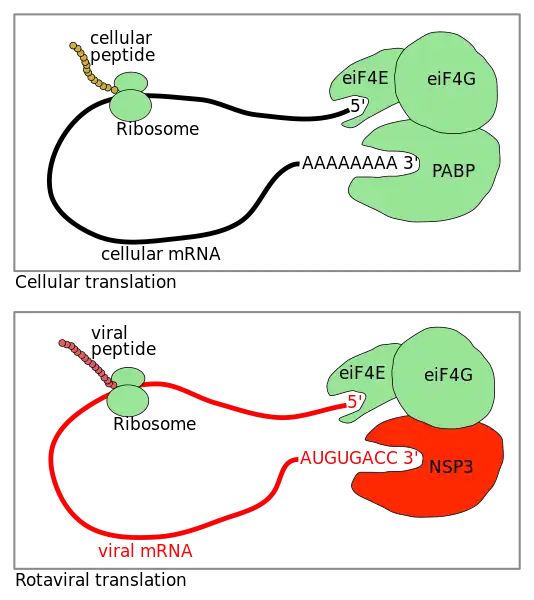| NSP3 (rotavirus) | |||||||||
|---|---|---|---|---|---|---|---|---|---|
| Identifiers | |||||||||
| Symbol | Rota_NSP3 | ||||||||
| Pfam | PF01665 | ||||||||
| InterPro | IPR002873 | ||||||||
| CATH | 1lj2A00 | ||||||||
| SCOP2 | d1lj2a_ / SCOPe / SUPFAM | ||||||||
| |||||||||

Rotavirus protein NSP3 (NS34) is bound to the 3' end consensus sequence of viral mRNAs in infected cells.[1]
Four nucleotides are the minimal requirement for RNA recognition by rotavirus nonstructural protein NSP3: using short oligoribonucleotides, it was established that the minimal RNA sequence required for binding of NSP3A is GACC.[2]
Rotavirus RNA-binding protein NSP3 interacts with eIF4GI and evicts the poly(A)-binding protein from eIF4F. And NSP3A, by taking the place of PABP on eIF4GI, is responsible for the shut-off of cellular protein synthesis.[3]
Expression of NSP3 in mammalian cells allows the efficient translation of virus-like mRNA: NSP3 forms a link between viral mRNA and the cellular translation machinery and hence is a functional analogue of cellular poly(A)-binding protein.[4]
Site-directed mutagenesis and isothermal titration calorimetry documented that NSP3 and PABP use analogous eIF4G recognition strategies, despite marked differences in tertiary structure.[5]
Using the yeast two-hybrid assay, RoXan a novel cellular protein was found to bind NSP3. The interaction between NSP3 and RoXaN does not impair the interaction between NSP3 and eIF4GI, and a ternary complex made of NSP3, RoXaN, and eIF4G I can be detected in rotavirus-infected cells, implicating RoXaN in translation regulation.[6]
References
- ↑ Poncet D, Aponte C, Cohen J (June 1993). "Rotavirus protein NSP3 (NS34) is bound to the 3' end consensus sequence of viral mRNAs in infected cells" (Free full text). Journal of Virology. 67 (6): 3159–65. PMC 237654. PMID 8388495.
- ↑ Poncet D, Laurent S, Cohen J (September 1994). "Four nucleotides are the minimal requirement for RNA recognition by rotavirus non-structural protein NSP3" (Free full text). The EMBO Journal. 13 (17): 4165–73. doi:10.1002/j.1460-2075.1994.tb06734.x. PMC 395339. PMID 8076612.
- ↑ Piron M, Vende P, Cohen J, Poncet D (October 1998). "Rotavirus RNA-binding protein NSP3 interacts with eIF4GI and evicts the poly(A) binding protein from eIF4F" (Free full text). The EMBO Journal. 17 (19): 5811–21. doi:10.1093/emboj/17.19.5811. PMC 1170909. PMID 9755181.
- ↑ Vende P, Piron M, Castagné N, Poncet D (August 2000). "Efficient translation of rotavirus mRNA requires simultaneous interaction of NSP3 with the eukaryotic translation initiation factor eIF4G and the mRNA 3' end". Journal of Virology. 74 (15): 7064–71. doi:10.1128/JVI.74.15.7064-7071.2000. PMC 112224. PMID 10888646.
- ↑ Groft CM, Burley SK (June 2002). "Recognition of eIF4G by rotavirus NSP3 reveals a basis for mRNA circularization". Molecular Cell. 9 (6): 1273–83. doi:10.1016/S1097-2765(02)00555-5. PMID 12086624.
- ↑ Vitour D, Lindenbaum P, Vende P, Becker MM, Poncet D (April 2004). "RoXaN, a novel cellular protein containing TPR, LD, and zinc finger motifs, forms a ternary complex with eukaryotic initiation factor 4G and rotavirus NSP3". Journal of Virology. 78 (8): 3851–62. doi:10.1128/JVI.78.8.3851-3862.2004. PMC 374268. PMID 15047801.